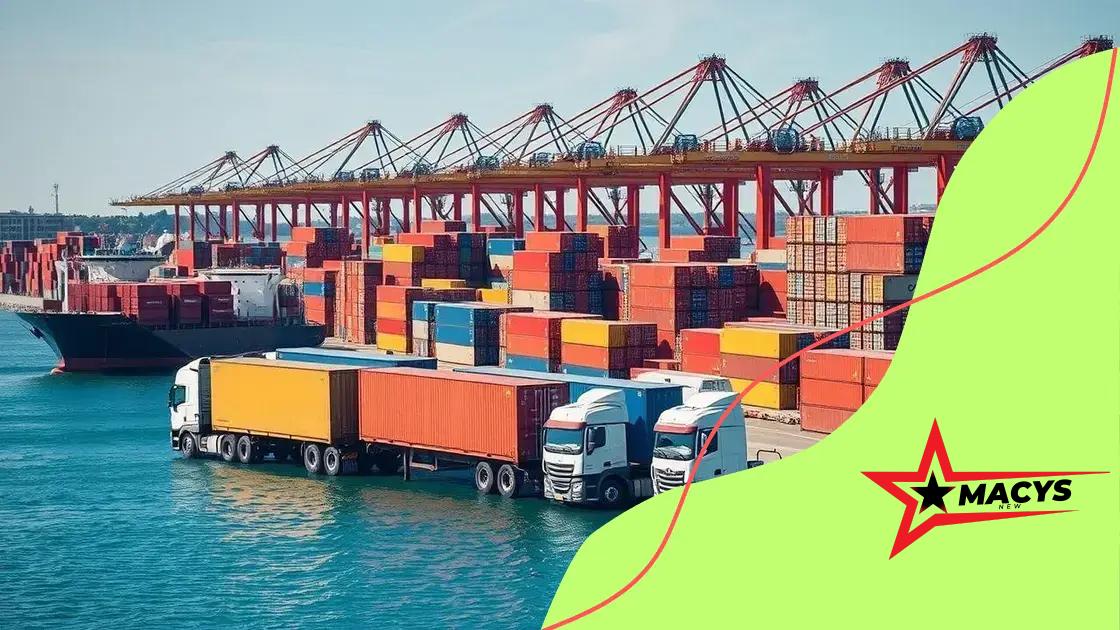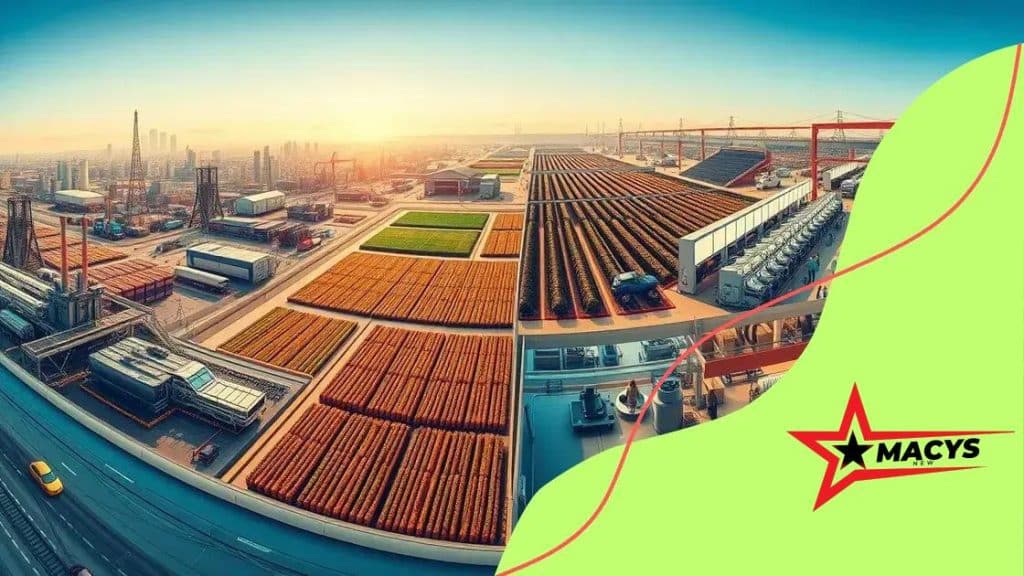US tariffs reach highest level since the 1930s: Economic impacts and global reactions

US tariffs have reached their highest levels since the 1930s, significantly impacting various sectors, consumer prices, and international trade relations.
US tariffs reach highest level since the 1930s. This shift not only reflects economic policies but also shapes everyday lives. What does this mean for consumers and businesses alike?
Understanding US tariffs and their history
Understanding US tariffs reach highest level and their history is crucial to grasping the current trade environment.
Tariffs have long shaped American trade policy, influencing both domestic markets and international relations. To appreciate their impact, we must review key historical events.
The discussion around tariffs today highlights how deeply embedded they are in economic policy and political debate.
Tariffs not only affect prices but also shape industrial strategies, influencing where companies invest and expand.
For historians and economists alike, understanding the evolution of tariffs provides insight into broader trends in U.S. commerce.
What are tariffs?
Tariffs are taxes on imported goods, intended to protect domestic industries. They make foreign products more expensive, encouraging consumers to buy U.S.-made items.
While tariffs can support domestic businesses, they often come with trade-offs, affecting international relations.
The modern economic landscape demonstrates that tariffs are rarely a simple tool; they influence both policy and consumer behavior.
Businesses must constantly adapt to tariff changes, balancing cost management with supply chain resilience.
For policymakers, understanding US tariffs reach highest level helps evaluate the trade-offs between protectionism and free trade.
Historical context
U.S. tariffs date back to colonial times, initially serving as a government revenue source. The Tariff of 1816 protected early American manufacturing from British competition.
During the Great Depression, the Smoot-Hawley Tariff of 1930 raised duties to record levels. Current debates show that lessons from history are still relevant when shaping modern trade policies.
Tariffs historically reflect the tension between domestic protection and global engagement. Recognizing these patterns helps anticipate economic and political consequences today.
Understanding how US tariffs reach highest level affects markets can guide modern policy decisions.
Key events in U.S. tariff history
- Tariff of Abominations (1828) created regional tensions.
- 19th-century protectionist measures promoted domestic industry.
- 20th-century trade agreements gradually lowered tariffs.
- Modern tariffs, influenced by geopolitics, remain critical to economic strategy.
Historically, shifts in tariff policy often coincide with major political and economic events. Understanding these changes provides context for current trade disputes and negotiations.
Tariffs have consistently served as a tool for governments to influence economic behavior, reflecting broader policy priorities.
Even when contentious, they remain central to discussions about US tariffs reach highest level and U.S. trade influence.

The economic impact of increasing tariffs
Rising tariffs significantly affect consumers and businesses. Understanding the economic impact is crucial as tariffs continue to evolve.
Consumer prices
Higher tariffs raise import costs, often passed on to consumers. Items ranging from steel to electronics can become more expensive.
Consumers may change purchasing habits, seeking alternatives or domestic products. Such shifts can ripple through the economy, affecting both supply chains and retail strategies.
Business operations
Companies face higher input costs when tariffs increase. Responses include reducing workforce, increasing prices, or sourcing elsewhere.
Smaller businesses often feel the impact first, struggling to absorb costs. Adaptation strategies can include innovation, operational adjustments, or relocation of production.
International trade relations
Tariff hikes can trigger retaliation and trade wars. Global supply chains and economic growth feel the strain when trade tensions escalate.
Trade diplomacy becomes more important, as negotiations may prevent full-scale retaliation. Understanding international responses is key to evaluating both risk and opportunity in global markets.
Policymakers consider how US tariffs reach highest level may influence long-term economic relationships.
Sectors affected by current tariffs
Tariffs on steel and aluminum raise production costs. Carmakers and construction firms face higher expenses, influencing pricing and output.
Industrial investment decisions may shift to avoid high tariffs. Companies might also explore domestic production alternatives to mitigate costs.
Agriculture
Farmers exporting goods abroad are impacted. Domestic surpluses can depress prices and reduce profitability.
Changes in trade policy often influence crop selection and long-term planning. Farmers may adjust strategies to diversify markets or invest in value-added products.
Technology and retail
Tech and consumer goods industries see rising costs. Production and retail prices may increase, affecting consumer choices.
Innovation becomes a response to mitigate tariff effects. Companies may invest in research to develop domestic supply chains and reduce import reliance.
Energy
Energy companies face higher equipment and material costs. Both fossils fuel and renewable sectors may experience operational challenges.
Long-term planning is affected, as project feasibility may depend on tariff considerations. Energy pricing and availability can fluctuate based on global and domestic policy shifts.
These examples illustrate how US tariffs reach highest level impact multiple industries simultaneously.
Global reactions to U.S. tariff policies
Countries often respond to U.S. tariffs with their own. The global cycle can intensify trade tensions and disrupt supply chains.
Negotiations and trade agreements aim to reduce conflicts. Multilateral cooperation can help mitigate negative effects on global commerce.
Investors closely monitor these developments, as tariff policy impacts financial markets. Shifts in trade flows affect global competitiveness and investment strategies.
The worldwide attention on US tariffs reach highest level shows their significance beyond U.S. borders.
Future projections of U.S. tariffs and trade relations
Policy shifts will determine whether tariffs continue or decrease. Trade agreements may lower duties, but geopolitical factors remain influential.
Global economic trends and emerging markets will shape future trade relations. Technological advancements may also influence which imports face tariffs.
Consumers and businesses must prepare for changes, adjusting purchasing and production strategies.
Proactive planning is key to navigating a landscape where US tariffs reach highest level continue to play a significant role.
As trade policies evolve, understanding the history, impact, and potential changes in tariffs is essential for all stakeholders.
FAQ – Frequently Asked Questions About U.S. Tariffs and Trade Relations
What are tariffs and how do they work?
Tariffs are taxes imposed on imported goods, designed to make foreign products more expensive and protect domestic industries.
How do tariffs affect consumer prices?
Higher tariffs usually lead to increased prices for imported goods, which can make products more expensive for consumers.
What sectors are most impacted by U.S. tariffs?
The manufacturing, agriculture, and technology sectors are significantly affected by tariff policies.
How can I stay informed about changes in U.S. tariffs?
Following reliable news sources, government announcements, and trade publications can help you stay updated on tariff changes.





